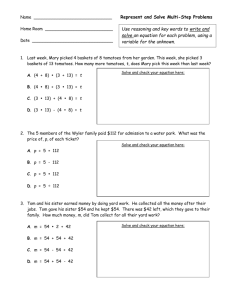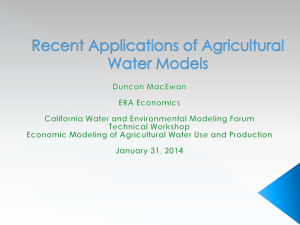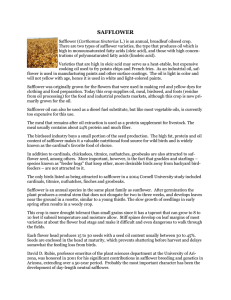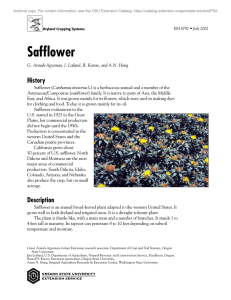Use of regional agricultural models
advertisement
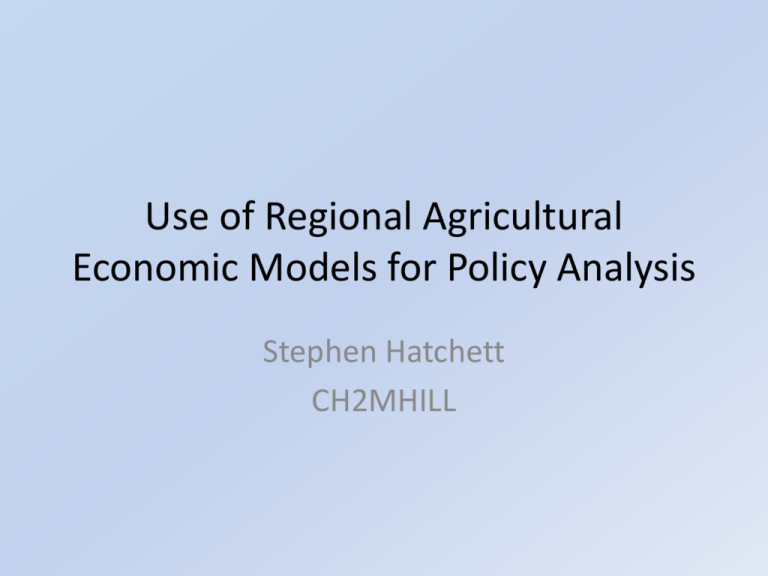
Use of Regional Agricultural Economic Models for Policy Analysis Stephen Hatchett CH2MHILL Why Use a Model at All? • Who is the client or consumer of the analysis? • What kind of analysis/estimate/projection is the client looking for? • Why do they want the analysis? Examples of Reasons for Economic Analysis of Agricultural Water Use • Policy analysis to inform public debate or decision • Impact of a new law or regulation • Evaluation of a specific proposed project (prepare EIR/EIS, estimate benefits, allocate costs) • Evidence for a judicial process (courts, SWRCB, watermaster) • Impact of a major event or trend (e.g., climate change or drought) Why Choose a Regional Optimization Model as the Approach? • Evaluate changes outside the range of observed data • Evaluate more than one simultaneous change in policy or condition • Explicitly recognize resource constraints • Assess a mix of behavioral responses to a policy change • Often need to show direct relationship and linkage to physical processes • Complex system with many parameters relative to data -- need to impose structure for tractability Characteristics of Regional Economic Models in Integrated Policy Analysis • Data needs are high and data is scrutinized by stakeholders • Policy changes often affect large, diverse regions • Economic analysis is backward linked (e.g., to physical and biological models) • Analysis is forward linked (e.g., to regional economic impacts, land use analysis, perhaps physical models) Economics Models Link Backward to Physical Models Climate Change Modified Hydrology Sea Level Rise VIC, ANN Reservoir/River Temp SRWQM, Reclamation Temperature Reservoir, River temperatures Fisheries Reclamation Mortality, SALMOD Survival, Potential Production, Population Groundwater Modeling CVHM Hydrology & System Operations CALSIM II Water supply impacts, river flows, exports, storage Delta Hydrodynamics DSM2-HYDRO Delta channel flows, stages, velocities Delta Water Quality DSM2-QUAL Salinity (EC, Cl, TDS, Br) and fingerprinting (EC, volume) Power LTGEN, SWP Power Net Generation and Use Economics SWAP, LCPSIM/OMWEM, LCRBWQM/SBWQM Quantification of Economic Benefits 6 Economics Models Link Forward to Other Analyses 7 Importance of Good, Consistent Data • Use best data set when possible, but “best” should consider: – – – – – – Timeliness Detail and accuracy Ease of updating Consistency across regions Consistency with other data in the economic model Consistency with data used in linked analyses • Rarely does one data set satisfy all of these A Good, Reconciled Data Set is Valuable • Stands up to scrutiny by experts and challenges by skeptical parties • Can be used by other analyses – Other, large-scale models, e.g. CVPM database used as basis of SWAP, DRMS model – Smaller scale or more focused analysis – Especially true if maintained in GIS SWAP Overview • Regional model of California agriculture • 27 regions in Central Valley (up to 33 statewide) • Calibrated to 2005 observed land and input use • Crops by aggregate crop groups (20) • Variable crop production that allows substitution among inputs: • Land, Labor, Water, and Other • Water sources include project supply, non-project surface water, groundwater • Data • CA Department of Water Resources and USBR data, UC Cooperative Extension Budgets, County Agricultural Commissioners reports, water district reports 10 Map of SWAP Subregions 11 Crop Groups SWAP Definition Almonds and Pistachios Alfalfa Corn Cotton Cucurbits Dry Beans Fresh Tomatoes Grain Onions and Garlic Other Deciduous Other Field Other Truck Pasture Potatoes Processing Tomatoes Rice Safflower Sugar Beets Subtropical Vines Proxy Crop Almonds Alfalfa Hay Grain Corn Cotton Summer Squash Dry Beans Fresh Tomatoes Wheat Dry Onions Walnuts Sudan Grass Hay Broccoli Irrigated Pasture White Potatoes Processing Tomatoes Rice Safflower Sugarbeets Oranges Wine Grapes Corresponding Proxy Crops in County Data ALMONDS ALL HAY ALFALFA CORN GRAIN COTTON LINT PIMA SQUASH BEANS DRY EDIBLE UNSPECIFIED TOMATOES FRESH MARKET WHEAT ALL ONIONS WALNUTS BLACK, WALNUTS ENGLISH HAY SUDAN BROCCOLI FRESH MARKET, BROCCOLI UNSPECIFIED PASTURE IRRIGATED POTATOES ALL TOMATOES PROCESSING RICE MILLING SAFFLOWER SUGAR BEETS ORANGES NAVEL GRAPES WINE 12 Example 1: Central Valley Project Improvement Act (CVPIA) • Passed and signed in 1992, implemented a number of changes to CVP water mgmt – Reallocation of water available for contractors – Tiered water pricing – Land retirement in drainage-affected area – Agricultural water conservation – Eased restrictions on water transfers – Water acquisition for F&W uses Example 1: CVPIA (cont.) • CVPM (precursor to SWAP) selected through a model screening process • Revised to allow analysis needed for CVPIA – Subregions and crop categories made consistent with DWR data – New code, e.g., for tiered water prices, irrigation efficiency, GW substitution, water transfers • Complete data update Example 1: CVPIA (cont.) COMPONENTS OF NET REVENUE LOSS, ALTERNATIVE 1 VS. NO-ACTION (IN MILLION $ PER YEAR) $1.8 $17.4 $28.7 Acreage Reduction $4.8 GW Pumping Irrig. System Cost CVP Water Cost Example 2: CALFED Program • Multi-agency, multi-objective plan for management and use of water from the Delta • CVPM/SWAP used in several projects: – EIR/EIS impact analysis – Estimated water transfer costs (quantity and price) for EWA program – Derived agricultural water demand functions – Used database to assess costs and AW reduction for Water Use Efficiency scenarios Other Examples • • • • Trinity River reoperation EIS Bay-Delta Conservation Plan benefits analysis DWR surface storage investigations CVRWQB Irrigated Lands Regulatory Program
